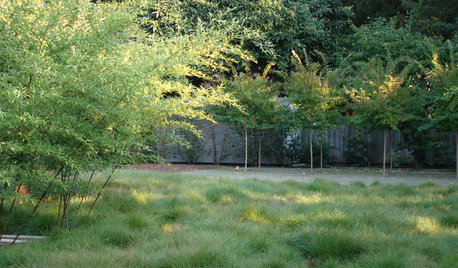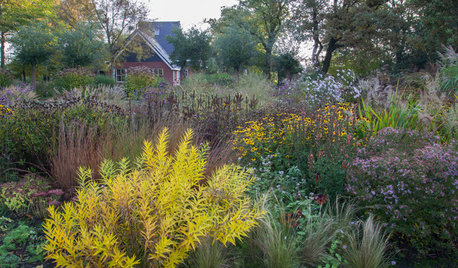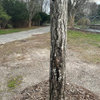How to overseed lawn & grow grass?
Neal Rich
4 years ago
last modified: 4 years ago
Featured Answer
Sort by:Oldest
Comments (62)
Related Discussions
What grass to overseed Pennington Ultimate Grass Lawn?
Comments (7)I disagree with Auteck's recommendation, and I'm a little surprised he recommended what he did. Your original grass seed mix selection was tall fescue, fine fescues and KBG. I suspect you have mostly tall fescue growing since you have bare spots. If the KBG in your original grass mix had germinated fully, then it should fill in bare areas in the sunnier parts of your lawn. I agree with him in that perennial rye is usually what is grown in your area, but there was no perennial rye in that original mix. Overseeding your lawn with it now will give you some throughout the whole lawn, but the bare spots will be all PR, and they will stand out against the TF you have now. My advice, use either all TF to overseed, or a mix that has similar percentages to your original mix. I would also stick with Pennington's as it is usually the best mix in the big box stores....See MoreSo much crabgrass in thin new lawn, how can I overseed?
Comments (6)I posted earlier but it must not have gone through. I would only till a couple areas that came in very poorly and it might just be more efficient to start over (a 15' wide stretch along the driveway, about 100' long). I just bought some quinclorac-based Drive XLR8 from John Deere Landscapes/Lesco this am, and they thought it would help and be safe for my grass. We'll see. My greatest concern is getting adequate seed-soil contact when I overseed in September, which will certainly be before the crabgrass starts dying on its own from frost. I'll try to get some pics up and then some follow up pics. It was $120 for the bottle to treat 1 acre, so we'll see....See Morehow do I get lawn grass to stop growing??m
Comments (2)teeka - Go ahead and spray, you won't harm the bamboo if you're carefull. Don't spray on a windy day, keep the sprayer on a tight stream, and stay low to the grass....See MoreHow soon can I overseed a New Lawn
Comments (4)Arrrrgh! I wish people would write in and ask about what they want to do rather than what they did. What you did (rototilling and adding more topsoil) are the two worst things you could have done. Adding topsoil to a landscape that already has good drainage can cause rainwater to back up into the house if you get too much. Rototilling fluffs the soil unevenly so that as it settles the surface becomes bumpier and bumpier - for the next 3 years. You will notice it the first time you mow. As for seeding again, yes, but do it NOW. Your initial timing was slightly late to give you some margin heading into the first frost, but if you are lucky, you might make it with more seed. I understand the wheatgrass, because it makes a beautiful turf with very low water requirements, but I believe all the wheatgrasses require full sun. It will germinate but not last long. It might make it into spring until the trees leaf out. Next time you do a full reno, here is a guide that should alleviate some of the issues that you and other people have. Note that this only applies for cool season grasses. Also note that for Atlanta this project should get going in late August with the first few steps so that you're seeding in Sept. Scalp everything down as low as possible (rent a mower if you don't want to ruin yours) Water daily for a few minutes, 3x per day for a week, trying to sprout all the weed seeds. Round Up everything. Continue daily watering for another week as before to sprout any slow germinating weeds. Round Up everything again. This double RU app will kill all the weeds you would have seen coming up among your new grass seed. Rake all the dead stuff away. Level as needed to fill low spots and holes. Slightly mound the holes to allow for settling. (Optional) Apply 1/4 inch of peat moss or compost as a bed for the seed. Sow seed and roll it down with a water fillable roller (rented). Water daily exactly like you did to sprout the weed seeds. For rye grass keep watering for 1 week to get 80% germination. For fescue water for 2 weeks. For Kentucky bluegrass, water for 3 weeks. Once you have 80% germination, cut back on watering to once a day for a few days. Then go to every other day and work your way back to once a week watering. Water more deeply to develop deeper roots. Mulch mow at your mower's highest setting when the grass gets up to 5 inches....See MoreNeal Rich
4 years agoNeal Rich
4 years agoNeal Rich
4 years agoNeal Rich
4 years agoNeal Rich
4 years agoNeal Rich
4 years agoNeal Rich
4 years agoNeal Rich
4 years agogardengal48 (PNW Z8/9)
4 years agoNeal Rich
4 years agoNeal Rich
4 years agoNeal Rich
4 years agoNeal Rich
4 years agoNeal Rich
4 years agoNeal Rich
4 years agoNeal Rich
4 years agoNeal Rich
4 years agoNeal Rich
4 years agoNeal Rich
4 years agoNeal Rich
4 years agoNeal Rich
4 years agoNeal Rich
4 years agoNeal Rich
4 years agoNeal Rich
4 years agoNeal Rich
3 years agoNeal Rich
3 years ago
Related Stories

GARDENING GUIDES5 Great Grasses for a New Lawn
Learn about maintenance, wear tolerance, ideal climate and more for these top turf choices to pick the right one for you
Full Story
LANDSCAPE DESIGNA Guide to the Grasses Available for Nontraditional Lawns
New grass mixes are formulated to require less water and less fertilizer
Full Story
GARDENING GUIDESSmall Gem Lawns: More Impact From Less Grass
Instead of letting the lawn sprawl, make it a shapely design element in your yard. You’ll reap benefits both practical and aesthetic
Full Story
GARDENING GUIDESGreat Design Plant: Purple Needle Grass, California’s State Grass
The long-lived, drought-tolerant Stipa pulchra is as admired for its benefits as for its good looks
Full Story
GARDENING GUIDESHow to Plant a New Lawn From Seed
Choose from more grass varieties and save money over sod by starting your lawn from seed
Full Story
LANDSCAPE DESIGN15 Great Ideas for a Lawn-Free Yard
End the turf war for good with hardscaping, native grasses and ground covers that save water and are easier to maintain
Full Story
LANDSCAPE DESIGN7 Low-Maintenance Lawn Alternatives
Turf isn't the only ground cover in town. Get a lush no-grass lawn with clover, moss and other easy-care plants
Full Story
NATIVE PLANTSHow to Grow a Garden From Seed
Planting grasses and flowers from seed is economical, minimizes garden maintenance and benefits local wildlife
Full Story
MOST POPULARMeet a Lawn Alternative That Works Wonders
Carex can replace turfgrass in any spot, is low maintenance and adjusts easily. Add its good looks and you’ve got a ground cover winner
Full Story
FRONT YARD IDEASInspiring Alternatives to the Traditional Lawn
Consider the many attractive and ecologically friendly alternatives to turfgrass
Full Story






a1an